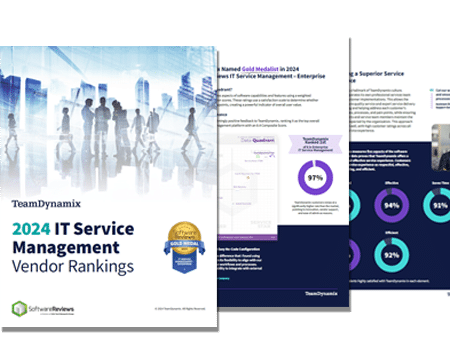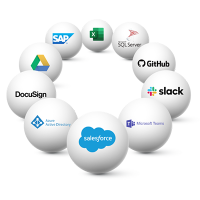
Understanding Change Management and Its Importance Within Your Organization
Did you know that a significant number of IT incidents occur when someone makes a change to one system that then affects other systems in

The Info-Tech ranking report offers a unique view of the market based entirely on in-depth customer interviews. Download the Info-Tech ITSM Quadrant and Customer Viewpoint report today.

We’ll show you some of our best situations and show you exactly how to execute them to get immediate results. The best part is, iPaaS tools often feature easy-to-use click and drag functionality, meaning you don’t need a dedicated employee building integrations and workflows.

System Integrators, Value Added Resellers, Technology Providers, and Buying Consortiums can benefit from a partnership with TeamDynamix.

The Info-Tech ranking report offers a unique view of the market based entirely on in-depth customer interviews. Download the Info-Tech ITSM Quadrant and Customer Viewpoint report to gain a better understanding of key vendor strengths and emerging market requirements.
Since early 2020, the global pandemic has caused a shift in the way businesses operate. Many find themselves running with limited resources and limited budgets. In addition, IT skills shortages are causing many organizations to find creative ways to get work done. One of these ways is by enabling “citizen developers” through the purchase of low-code or no-code platforms. According to Gartner, a no-code platform can give employees a 4.6X productivity gain when compared to traditional programming. That kind of speed to market can be the difference between success and failure.
Low-code/no-code solutions have been gaining in popularity in recent years because they democratize technology that was previously only available to developers and makes it available to anyone. Unlike traditional scripting, these platforms feature prebuilt drag-and-drop actions and tasks that you can use to build out flows and automate actions. Using a no-code or low-code platform can save your staff time and money. Especially when it comes to tackling integration backlogs.
IT Service Management (ITSM) platforms often form the foundation for many organizations’ service management processes. Because they are so integral, it’s important they don’t drain already scarce IT resources. This is why so many CIOs are turning to codeless ITSM solutions. With the right codeless ITSM software, you can:
For CIOs looking to relieve budgets and reduce the drain on IT resources, a codeless platform for ITSM is the answer. This will give way to allocate budget to more strategic initiatives such as enterprise integration leveraging iPaaS platforms.
Moving to TeamDynamix for IT Service Management has allowed tech staff at Great Eastern Resort to reclaim all that lost time and eliminate frustration. “The difference is like night and day,” Ronald Johnson, a help desk technician with the resort, said.
In searching for a new ticketing system, Support Manager Brandon McNeely involved his entire IT support team in the decision. They wanted an all-inclusive, web-based IT Service Management platform that could also handle asset and Project Portfolio Management.
“One of the things we look for in any new product is, if we implement it, how many resources do we get to free up?” McNeely explains. Implementing TeamDynamix has allowed Great Eastern Resort to retire at least three different systems, he notes: its old ticketing system and a database server, as well as the company’s old asset management system.
After reviewing multiple products, the team chose TeamDynamix because they liked how easy it was to use. “The platform’s no-code design allows IT staff to customize the software easily” explained McNeely. “Without having to spend valuable time and resources on coding, we can easily configure the system to meet our unique needs. The interface is also highly intuitive for employees to use.
“I’ve had a lot of feedback from our client base saying they love the simplicity of TeamDynamix,” Johnson said. “It’s so much easier to submit a ticket to us. That makes everything flow a lot better, and it allows us to help our end-users quicker.”
TeamDynamix allows IT staff at Great Eastern Resort to work more efficiently. For instance, McNeely’s team has developed automated workflows for onboarding new hires and routing tickets instantly to the appropriate technician, leading to faster response times. “We’ve probably only scratched the surface in terms of what TeamDynamix can do from an automation standpoint,” he said.
Because his team couldn’t do a lot of data tracking with its old ticketing system, McNeely says it’s hard to quantify how much time his IT technicians are saving using TeamDynamix—but he says it’s significant. “It’s so much easier to create a ticket in TeamDynamix than in our previous system,” he observed.
When it comes to Integration Platform as a Service (iPaaS) it’s even more important to have codeless functionality.
When you use iPaaS to integrate your point solutions and APIs you can unlock a level of productivity you’d not be able to reach otherwise. And using iPaaS throughout your organization can enable the citizen developers through your various lines of business in marketing, HR, facilities, etc. to integrate and automate some of their most time-consuming activities – meaning they don’t add to the drain on IT resources.
For example, in HR you can use iPaaS to fully automate the onboarding or offboarding process for employees. One simple action, like a signed offer letter, can kick off a series of event-based triggers that fully automate the creation of an employee record, the provisioning of technology and equipment to even sending a welcome gift.
But you can also reduce resource drain and toil within IT with iPaaS.
A recent study from InformationWeek found:
In addition, the survey found that 90 percent of respondents felt these types of repetitive manual IT tasks directly contributed to low morale and attrition within their IT organizations.
When asked to rank these types of tasks, the study found the top 5 time-wasting tasks are:
By enabling your staff through a codeless iPaaS solution, you can increase employee satisfaction and productivity while also increasing revenue.
When TeamDynamix first released iPaaS, Western University of Health Sciences was one of the first organizations to purchase and use it. “We definitely jumped at the opportunity to get iPaaS,” David Mitchell, Enterprise Application Administrator, said.
One of the key objectives for Mitchell and his team has been finding ways to save technicians time and make them more efficient – iPaaS lends itself nicely to that. “We are looking at what can save our technicians time, what are we already doing that may be more efficient with iPaaS and what systems do we need to integrate with iPaaS,” he said.
WesternU started by automating simple tasks with iPaaS, things like automatic VPN access for approved users, keeping assets up to date and reconciling data between Active Directory and Banner. “A lot of these tasks aren’t tasks that are necessarily hard for anyone to do manually, it’s more that they are repetitive and time-consuming.”
And for Mitchell and WesternU, that’s been one of the biggest draws for iPaaS.
One use case, in particular, has been beneficial for WesternU and that’s the workflow they built to address out-of-compliance Mac computers. Mitchell said they were having an issue with people taking home devices and then never using them again, so they built a workflow to monitor computer assets.
What the workflow does is add Macs that haven’t checked in for 365 days to a group in Jamf. That group gets monitored by a webhook in Jamf that then sends data to iPaaS.
When iPaaS receives the data, it pulls the details from Jamf and the details from TDX Assets. A ticket is then created automatically for the appropriate group with information about the Mac (who the owner is, its location, etc.). A post is also created in a special Microsoft Teams channel with all of the same information as the ticket, with links.
By automating tasks, especially the repetitive ones, Mitchell said their technicians now have time to focus their attention on bigger issues. “We’ve been working in iPaaS since January and I feel like we’ve already come a long way and are saving time,” he said. “But there’s so much more we can do.”
For Mitchell, the codeless drag-and-drop functionality of iPaaS has really enabled him and his team to move quickly and creatively when it comes to building new workflows.
“I’m not a programmer at all,” Mitchell said. “I don’t know the programming languages, I’m kind of illiterate when it comes to that, but I like to call iPaaS Lego programming because you just snap everything together and it works.”
At Pima County, one of the goals of bringing on TeamDynamix for ITSM and iPaaS is to reduce toil.
“People feel so much more empowered and have so much more worth when they are doing things that are intellectually rigorous and challenging versus when they are just repeating the same mechanical actions over and over and over with very little thought,” Mark Hayes, information technology leader at Pima County, said.
“Our ITSM is our entry point to our entire IT organization, and we want our employees to graduate out of this area into other roles within our organization – network technicians, client services, desktop technicians, developers and project managers,” he continued. “If all they’re doing is handling tickets and doing the same mundane, manual tasks over and over that’s not particularly great training. So investing in tools that allow our employees to engage in meaningful work is something that’s important to us as an overall IT organization.”
With TeamDynamix now in place, Pima County is looking to automate and integrate as much of the manual ITSM processes into workflows as they can.
“The drudgery of working through mundane, repetitive tasks doesn’t exist just in IT,” Hayes said. “I think the more we can reduce toil within the departments that we support, the more people are going to buy in and understand the value of what we’re trying to achieve. There’s nothing like success to breed more success, and once other departments see the benefits they’re going to want these tools too.”
To learn more about how codeless platforms are supercharging organizations across industries check out: Smart Service Management: Working Better Together With a Connected Enterprise
This post was originally published in May 2021 and has been updated with new information.

Did you know that a significant number of IT incidents occur when someone makes a change to one system that then affects other systems in

The construction industry can be very volatile, with a high employee turnover rate due to seasonal fluctuations in the workforce. A key challenge for the

A study from Information Week and TeamDynamix shows companies are looking to invest in IT Service Management (ITSM) software that is simple to administer and
TeamDynamix’s award-winning SaaS cloud solution offers IT Service and Project Management together on one platform with enterprise integration and automation.
[email protected]
(877) 752-6196
Contact Us
